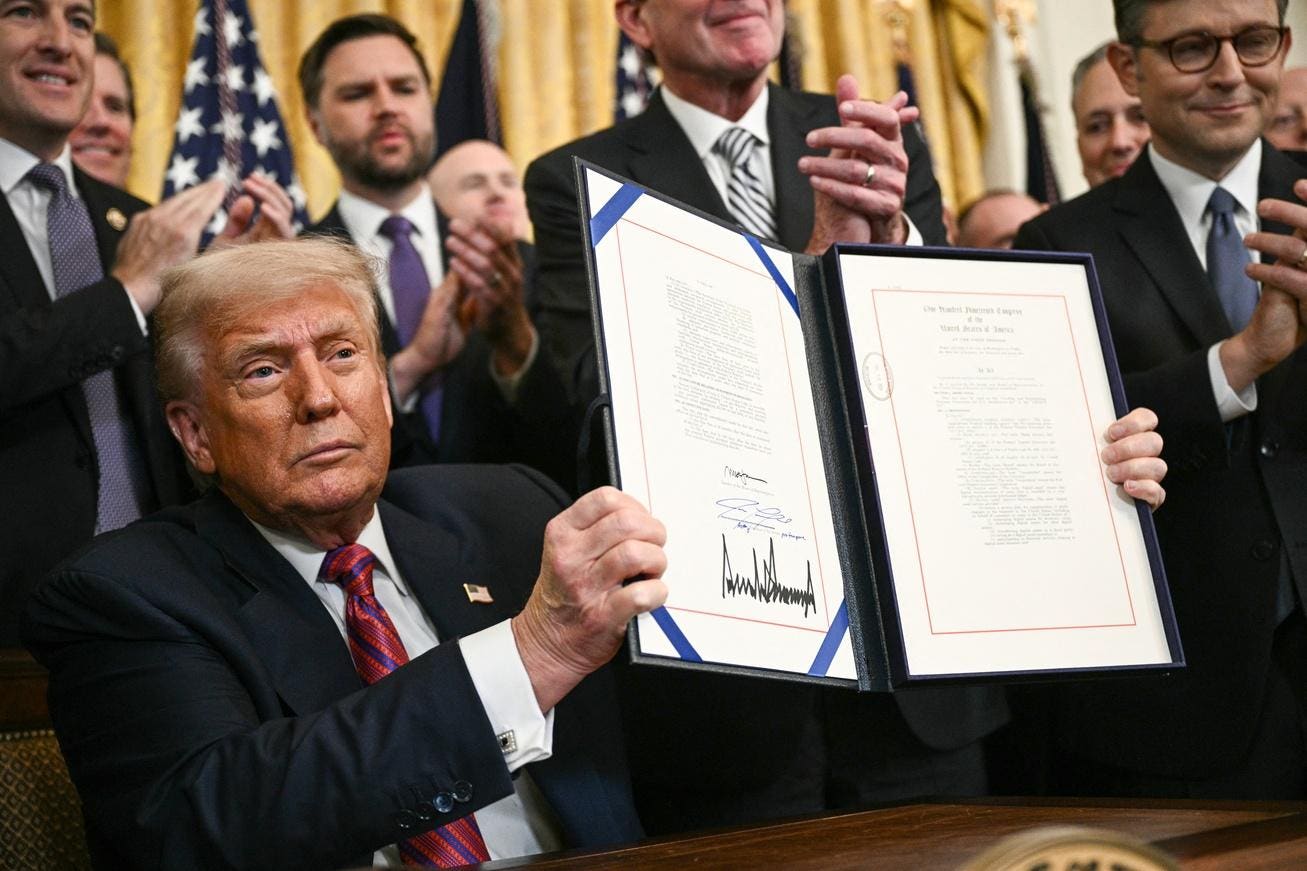TOPSHOT – US President Donald Trump displays the GENIUS Act (Guiding and Establishing National … More
The global stablecoin market, surpassing $250 billion, is being reshaped by regulatory frameworks that will define competition and innovation. The U.S.’s Guiding and Establishing National Innovation for U.S. Stablecoins Act (GENIUS Act), passed by the House and signed into law by President Trump on July 18, 2025, and Hong Kong’s Stablecoins Ordinance, enacted on May 21, 2025, and effective August 1, 2025, present contrasting approaches to governing fiat-referenced stablecoins. As an industry practitioner immersed in global policy and market dynamics, I am closely observing how these regulations will influence issuers, investors, and geopolitical strategies. Let’s take an analytic look at their competitive impact, spotlighting Hong Kong’s role in advancing China’s Belt and Road Initiative (BRI) through stablecoin adoption in Global South economies.
Regulatory Frameworks: Contrasting Visions
The U.S. GENIUS Act establishes a tiered regulatory structure. Issuers with over $10 billion in circulation face federal oversight by the Office of the Comptroller of the Currency (OCC) or banking regulators, while smaller issuers can opt for state-level regulation, subject to Treasury approval. Reserves must be 1:1 backed by high-quality liquid assets (e.g., U.S. Treasuries ≤ 93 days, cash), with bans on yield-bearing stablecoins and lending activities. AML/KYC compliance under the Bank Secrecy Act is stringent, with penalties up to $100,000 per day for violations.
Hong Kong’s Stablecoins Ordinance, part of the LEAP framework (Licensing, Education, Application, Protection), requires issuers to be locally incorporated with a minimum capital of HKD 25 million (USD 3.2 million), though banks are exempt. Reserves must be 1:1 backed by liquid assets, with the flexibility to issue stablecoins pegged to any official currency, such as HKD, USD, or offshore RMB, leveraging Hong Kong’s currency peg. The Ordinance focuses on fiat-referenced stablecoins (FRS), excluding algorithmic stablecoins due to their lack of effective stabilization mechanisms, aligning with Financial Stability Board recommendations. AML/CFT requirements meet FATF standards, with penalties up to HKD 5 million (USD 640,000) and seven years’ imprisonment.
Competitive Impact: Consolidation vs. Selective Innovation
U.S.: Consolidation and Dollar Dominance
The GENIUS Act prioritizes financial stability and U.S. dollar dominance, creating a high-compliance environment that favours large issuers like Circle (USDC). Federal oversight for issuers exceeding $10 billion, coupled with costly AML/KYC and audit requirements (estimated at $5M–$10M annually), drives market consolidation. For a $100 million issuance, a 0.5% operational cost equals $500,000 in expenses, challenging smaller issuers’ profitability without significant scale.
Photo by Jakub Porzycki/NurPhoto via Getty Images
The ban on algorithmic stablecoins and restrictions on high-risk activities, such as lending, limit DeFi innovation, pushing issuers toward a banking-like model. This constrains growth loops in retail adoption but attracts institutional players, leveraging the U.S.’s leading position in the stablecoin market, driven by USD-pegged tokens like USDC and USDT. Requiring U.S. Treasuries in reserves aligns with national interests, boosting government borrowing power. However, high costs and lack of international coordination risk regulatory arbitrage, with issuers eyeing more flexible jurisdictions like Hong Kong and the UAE.
Hong Kong: Selective Innovation and Regional Hub
Hong Kong’s Stablecoins Ordinance balances compliance with innovation but favours larger issuers. The HKMA’s plan to issue a “single-digit” number of licenses in 2025, as stated by Secretary Christopher Hui, signals a selective process prioritizing well-capitalized firms with robust compliance frameworks. While the HKD 25 million capital threshold is accessible, compliance costs (0.3%–0.5% of issuance, e.g., HKD 3M–5M for a $100M stablecoin) and stringent licensing criteria (e.g., monthly audits, AML/CFT) challenge smaller issuers, limiting their competitiveness. The exclusion of algorithmic stablecoins and lack of support for DeFi applications focus innovation on fiat-backed models, such as tokenized bonds and real-world asset (RWA) tokenization under LEAP’s application pillar.
Photo by Chen Yongnuo/China News Service/VCG via Getty Images
The Ordinance’s flexibility to issue stablecoins pegged to any official currency, including HKD, USD, or offshore RMB, enhances Hong Kong’s competitiveness, attracting issuers targeting Asia-Pacific and global markets. This aligns with China’s BRI by facilitating cross-border transactions in multiple currencies. The Bill’s clarity and FATF-aligned standards position Hong Kong as a compliant hub, competing with Singapore and the UAE. However, the local incorporation requirement and selective licensing may deter smaller foreign firms, favouring established players with regional presence.
Geopolitical Implications
U.S. Dollar Dominance through Stablecoins
The GENIUS Act is a strategic tool to extend U.S. dollar dominance into the digital realm, reinforcing the dollar’s role as the world’s reserve currency. By mandating that stablecoin reserves be backed 1:1 by high-quality liquid assets, primarily U.S. Treasury bills and cash, the Act ensures that USD-pegged stablecoins, which dominate over 90% of the $250 billion market, directly bolster U.S. government debt. For example, a $100 billion stablecoin issuance backed by Treasuries increases demand for U.S. debt, effectively funding government borrowing. This creates a powerful feedback loop: as stablecoin adoption grows for cross-border payments and digital transactions, so does the global demand for USD and Treasuries, cementing U.S. financial hegemony.
This strategy, however, has triggered global pushback. The requirement for USD stablecoin holders – whether individuals, businesses, or institutions – to indirectly finance U.S. debt via Treasury-backed reserves is viewed unfavourably in jurisdictions seeking monetary sovereignty. Countries are countering with their own stablecoin regimes to promote local currency-pegged tokens:
- Hong Kong’s Ordinance allows stablecoins pegged to any currency, including the offshore RMB
- Singapore’s Single-Currency Stablecoin (SCS) Framework licensing prioritizes SGD-pegged stablecoins
- Bahrain’s framework (July 4, 2025) supports dinar-pegged tokens
- South Korea’s June 2025 proposal encourages won-pegged stablecoins
- Japan’s June 2023 Payment Services Act promotes yen-backed stable tokens
- The UAE’s September 2024 framework fosters dirham-pegged payment tokens
- Kazakhstan is piloting a tenge-pegged stablecoin, with regulations expected by late 2025
- The UK is drafting rules (due Q4 2025) for GBP-pegged stablecoins.
These regimes aim to protect sovereign currencies and assert financial autonomy in a digital transaction world increasingly powered by US dollar backed stablecoins.
Hong Kong and the Belt and Road
Hong Kong’s stablecoin framework can be seen as an extension for China’s Belt and Road Initiative (BRI), a $1 trillion infrastructure and trade network spanning 150+ countries, particularly in the Global South. Stablecoins offer a transformative solution for cross-border payments, which often incur 5%–7% fees in BRI corridors. A $10 million trade settlement via HKD-, USD-, or RMB-pegged stablecoins could save $500,000, enhancing efficiency for projects like ports in Pakistan, railways in Kenya, or energy hubs in Indonesia. By enabling stablecoin issuance in multiple currencies, including the offshore RMB, Hong Kong strengthens China’s financial influence in regions with volatile local currencies, supporting BRI’s goal of fostering trade and investment.
Stablecoins also advance BRI’s digital transformation objectives. In Global South economies, where trust in local banking systems is low, regulated stablecoins provide a stable medium for trade, remittances, and project financing. For instance, African exporters or Southeast Asian SMEs could use RMB- or USD-pegged stablecoins for instant, low-cost transactions, reducing reliance on Western financial networks. The LEAP framework’s education pillar promotes blockchain literacy, while its application pillar encourages tokenized asset adoption, positioning Hong Kong as a financial bridge between China and BRI partners. Potential integration with China’s digital yuan could create hybrid payment systems, amplifying China’s role in global digital finance and challenging U.S. dominance.
Conclusion: Navigating a Fractured Digital Financial Future
The U.S. GENIUS Act, signed into law on July 18, 2025, and Hong Kong’s Stablecoins Ordinance, effective August 1, 2025, represent divergent paths in the global stablecoin race. The U.S. drives market consolidation and dollar dominance through leveraging USD-pegged stablecoins’ market leadership and tying stablecoin reserves to U.S. Treasuries strengthens its financial hegemony, though global pushback from different jurisdictions may signal a general shift toward sovereign stablecoin regimes.
Hong Kong’s selective licensing favours established issuers, with its flexibility to peg stablecoins to any currency, including the offshore RMB, enhancing its role as a BRI-driven hub. This multi-currency approach positions Hong Kong to capture Asia-Pacific markets and support China’s global financial ambitions.
Issuers face a stark choice: navigate the U.S.’s rigid but dominant market or Hong Kong’s selective yet innovative ecosystem. As stablecoins reshape global finance, this regulatory rivalry underscores a broader battle for digital currency supremacy, with profound implications for economic sovereignty and cross-border trade.


